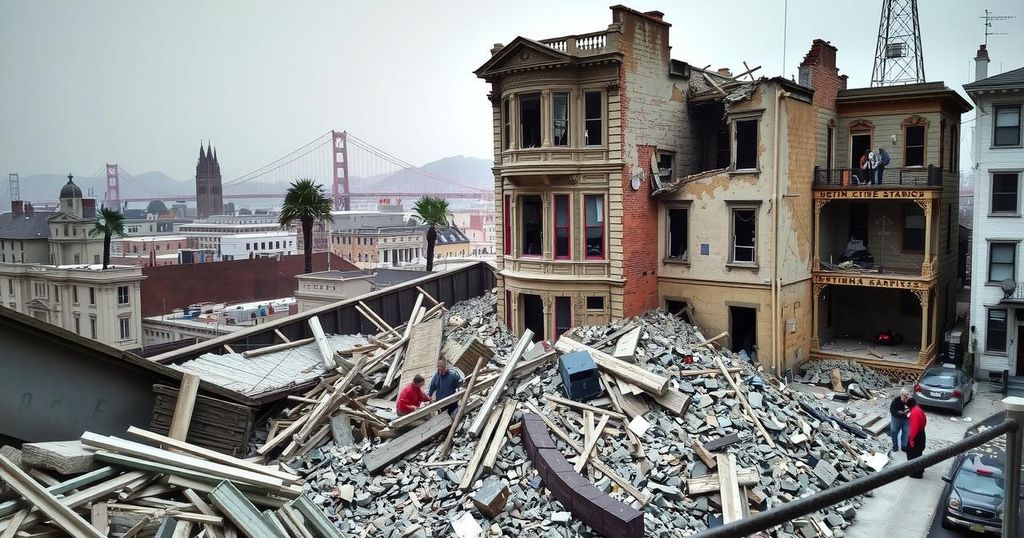On April 18, 1906, the San Francisco earthquake registered a magnitude of 7.9, causing extensive damage across the region. Resulting fires obliterated over 28,000 buildings and left around 3,000 dead, with 250,000 homeless. Relief efforts aided rapid reconstruction, leading to improvements in urban safety and planning. The event fundamentally reshaped the city and contributed to advancements in seismic understanding.
The San Francisco earthquake of 1906, measuring 7.9 in magnitude, struck on April 18 at 5:12 a.m. It originated along the San Andreas Fault, a segment that extends approximately 270 miles, affecting areas from San Juan Bautista to beyond Humboldt County and into the ocean. The quake’s impact was widespread, with its tremors felt as far south as Los Angeles and as far north as Coos Bay, Oregon. The cities neighboring the fault, including San Jose and Santa Rosa, also experienced significant damage.
This event was unprecedented compared to previous quakes in San Francisco in 1864, 1898, and 1900; however, none matched the severity of the 1906 disaster. Eyewitness accounts describe a terrifying noise comparable to “the roar of 10,000 lions” as the city rapidly shook. Cable car operations halted immediately, debris fell from structures such as City Hall, and glass shattered from the Palace Hotel, littering the area below.
In the aftermath, a massive fire engulfed the city, particularly affecting the business districts near Montgomery Street, spreading through Russian Hill, Chinatown, and beyond. The inferno lasted for four days, extinguished only by rainfall, destroying over 500 city blocks—approximately four square miles—and obliterating around 28,000 buildings. Estimates suggest that property losses exceeded $350 million. Initially, around 700 fatalities were recorded, but historical analysis now indicates that the death toll likely surpassed 3,000. Additionally, approximately 250,000 residents were rendered homeless, many of whom sought refuge in Golden Gate Park and nearby areas or fled to other towns.
In the wake of this disaster, relief efforts commenced promptly, with food, clothing, and financial assistance pouring in from various sources internationally. The insurance payouts reached nearly $300 million, yet recovery and reconstruction relied heavily on the determination and resilience of the local populace. The reconstruction effort emphasized creating a city that was more resistant to both earthquakes and fires, ultimately leading to significant civic development initiatives. By 1915, San Francisco showcased its recovery efforts through the Panama-Pacific International Exposition.
Geological studies following the earthquake significantly advanced understanding of seismic activity, particularly the elastic rebound theory describing the mechanics behind earthquakes.
The San Francisco earthquake of 1906 serves as a crucial historical event, exemplifying the destructive power of natural disasters and the subsequent resilience of affected communities. It occurred along the San Andreas Fault, a known tectonic boundary that has produced significant seismic activity in California. Prior earthquakes in the region had prepared the populace for natural disturbances, but the magnitude and consequences of the 1906 quake surpassed previous experiences. The event was further exacerbated by the fire that followed, leading to extensive damage and loss of life, highlighting both the vulnerabilities of urban environments and the triumph of human tenacity in rebuilding efforts after devastation.
The 1906 San Francisco earthquake stands as a stark reminder of nature’s power and the human capacity to recover from calamity. With a magnitude of 7.9, the earthquake caused catastrophic damage and loss of life, leading to significant changes in urban planning and building standards aimed at mitigating future disasters. The collective effort of local and international communities helped San Francisco to not only recover but also to innovate and improve its infrastructure for future resilience.
Original Source: www.britannica.com






